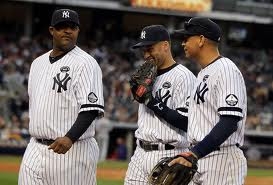The other side of the spending spectrum contains winners as well. Penny-pinchers like the Tampa Bay Rays, Cincinnati Reds and, to an extent, the Texas Rangers are perennial "Next Year Is The Year" teams, as their star prospects always seem to take longer to get to the big leagues than necessary. The Rays were, and still are contenders with a very low salary. They developed talented players like third baseman Evan Longoria, and outfielders B.J. Upton and Carl Crawford, and still managed to win games, even if they were in the same divisions as the aforementioned Yankees and Red Sox. They have faith in their general managers and in their ability to draft well. These teams are often very efficient with costs and players. When players become stars on cost-effective teams, they either have become attached to the area, like Reds first baseman Joey Votto, or leave for bigger markets, like Crawford, but that is an obvious risk with prospects, as they can quickly become expensive luxuries and sign elsewhere, whereas a free agent is a known value and is signed to a longer deal that is generally more team-friendly in the long run, for a prospect's price goes up when an older free agent's goes down. The Cincinnati Reds, like the Rays, have consistently had one of the lower payrolls in Major League Baseball. They traded big stars like Ken Griffey Jr. and Adam Dunn, who was developed in the system, for prospects, to make room for players they drafted. Griffey Jr. made room for slugging outfielder Jay Bruce, who was drafted and developed in the Reds farm system. Then, Joey Votto, was drafted, signed, and resigned to be a career Cincinnati Red. On opening day, five of the nine starting players were drafted by the Reds. When these prospects become too expensive, as Bruce and pitcher Johnny Cueto might, there will be others waiting at the doorstep to step up. A similar situation unfolded in Texas, as the Rangers lost one of the most popular players in baseball, pitcher C.J Wilson to the Angels. Wilson was brought up by the Rangers, as were potential-laden players like Neftali Feliz and Elvis Andrus. Wilson's free agency was a hot topic, as he was very expensive but not necessarily worth the money he was demanding, so those who wanted to win now campaigned for a new deal, while others realized that a prospect like Feliz could fill the void without much of a drop in performance, if at all.
Different teams have different philosophies. The big spenders have to win now, and their method of acquiring players or filling needs reflects that attitude. Rather than wait for prospects, teams like the Yankees, Red Sox, and Phillies attack the free agent market with reckless abandon, while other teams like the Rays, Reds, and Rangers are more patient and fill their needs with players they drafted and nurtured. Both philosophies have a proven track record, as every team mentioned, save the Reds, though they may get there soon, has been to the World Series in the last five years, regardless of whether or not they got there with players they bought. Some teams choose to spend; others have to to maintain a steady fanbase and revenue source. Some teams choose to stick with their own players; others have to due to a lack of resources. The only question is, which do you prefer?
Images retrieved from: www.bleacherreport.com


No comments:
Post a Comment